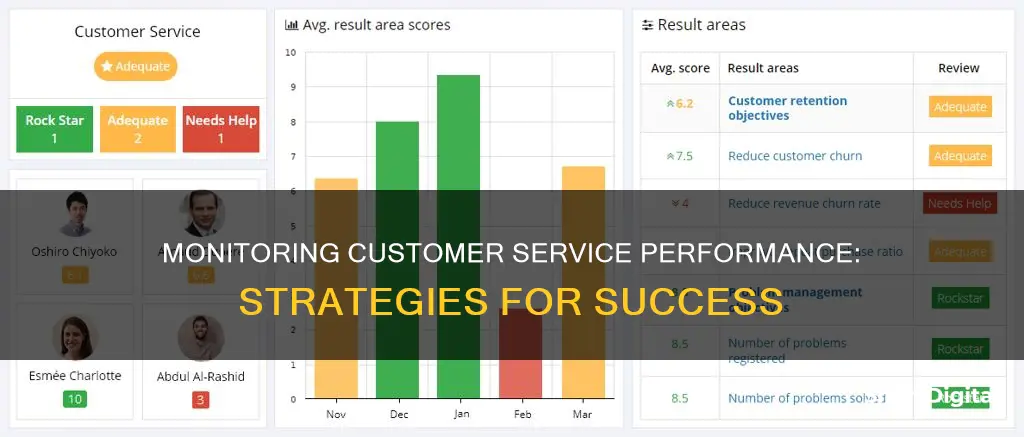
Monitoring customer service performance is crucial for businesses to retain customers, encourage repeat business, and establish a positive reputation. It helps identify areas for improvement and ensure customer satisfaction. There are several methods to monitor customer service performance, including customer feedback through surveys, social media monitoring, analysing written and telephonic correspondence, tracking key performance indicators (KPIs), and assessing active and resolved issues. By combining these approaches, businesses can gain valuable insights to enhance their customer service and overall success.
What You'll Learn

Customer feedback
One of the most well-known methods of collecting customer feedback is through surveys. Surveys can be short or long and are typically sent via email or pop up on a company's website. Short surveys tend to have higher response rates, so it is important to keep them concise and only include necessary questions. Long-form surveys allow for more detailed responses but run the risk of lower completion rates. It is also important to use a consistent rating scale and avoid leading or loaded questions.
Email and Customer Contact Forms
Email is an easy and effective way to collect customer feedback. It is a support channel for most companies, and each interaction can be an opportunity to gather feedback. It is important to set clear expectations and let customers know when they can expect a response. Organising email feedback through a system, such as creating "boards" on Trello, can help keep track of feedback and ensure that no insights are missed.
Exploratory Customer Interviews
Direct outreach and customer interviews provide valuable qualitative stories from customers that bring colour and nuance to quantitative feedback. They help to understand the feelings behind customer decisions and brand responses. It is important to ask open-ended questions, practice active listening, and maintain eye contact during these interviews to create a comfortable environment for the customer to share their thoughts.
On-Site Activity via Analytics
Analytics tools can provide valuable insights into how customers interact with a company's website or digital product. They can track the number of visitors to each page, average time spent on a page, and bounce rates. This information can be used to improve the user experience and make data-driven decisions about website design and content.
Instant Feedback from Your Website
Embeddable on-site widgets, such as Beacon, can collect instant customer feedback without asking any questions. For example, by pulling multiple articles into a webpage, Beacon can collect data on the most popular articles without directly asking customers for their preferences.
Social Media Monitoring
Social media has become a crucial channel for sharing opinions and experiences. By tracking social media channels, companies can monitor brand conversations and gain insights for better business decisions. Social media listening tools, such as Brand 24 and Mention, can help analyse brand conversations and understand customer perceptions.
Other Methods
Other methods of collecting customer feedback include live chat sessions, feedback boxes, heatmaps, in-app feedback, and Net Promoter Score (NPS) surveys. It is important to choose the right channels and methods that align with your business objectives and target audience preferences.
Buy Sleep Oxygen Desaturation Monitors: Top Places to Consider
You may want to see also

Active and resolved issues
Keeping track of active and resolved issues is a vital aspect of monitoring customer service performance. This involves maintaining a record of customer inquiries or complaints and their respective statuses – whether they are currently active or have been resolved. By regularly reviewing these records, businesses can gain valuable insights into the efficiency and effectiveness of their customer service operations.
When monitoring active and resolved issues, it is essential to track the volume and nature of the issues over time. This includes documenting new issues as they arise and updating the records when issues are resolved. It is also crucial to categorise the issues appropriately, identifying common themes or trends. For instance, are there specific types of products or services that generate more complaints than others? Are there particular stages in the customer journey that consistently present challenges? By analysing this data, businesses can identify areas requiring improvement and allocate resources accordingly.
The timely resolution of customer issues is a critical factor in maintaining customer satisfaction and loyalty. Therefore, businesses should strive to minimise the number of active issues by addressing them promptly and efficiently. This may involve setting clear guidelines for response times, ensuring adequate staffing, and providing ongoing training for customer service representatives to enhance their problem-solving skills. It is also essential to monitor the quality of resolutions, ensuring that they meet the customers' needs and expectations.
Furthermore, tracking active and resolved issues enables businesses to identify any recurring problems. If certain issues are repeatedly appearing on the active list, it indicates a need for more sustainable solutions. This may involve reviewing existing policies, procedures, or products and making necessary adjustments to prevent the same issues from arising repeatedly. It is also essential to communicate with customers throughout the resolution process, keeping them informed about the status of their inquiries and any actions taken.
By effectively managing active and resolved issues, businesses can enhance their responsiveness to customer needs, improve customer satisfaction, and foster long-term customer loyalty. It enables businesses to identify trends, patterns, and areas of improvement, allowing them to refine their customer service strategies and make data-driven decisions. Ultimately, by prioritising the timely and effective resolution of customer issues, businesses can build stronger relationships with their customers and enhance their overall brand reputation.
The Ultimate Guide to VESA Mounts for ASUS MX279H Monitors
You may want to see also

Response speed
Tracking Methods
- Monitor the average duration between a customer reaching out and the response time of a customer service agent. This is known as the "first response time" and is a crucial metric for measuring customer satisfaction.
- Calculate the "average resolution time" by finding the sum of all case resolution durations and then dividing it by the total number of customer cases.
- Keep track of active and resolved issues to understand how efficiently your system is working. If the list of active issues is longer than the resolved ones, it indicates a problem that needs attention.
- Utilize customer feedback to assess response speed. Customers can provide insights into their satisfaction with response times and areas where improvements can be made.
Strategies for Improvement
- Ensure that your system routes customers to the right representative as quickly as possible.
- Address any issues causing delays, such as a bad product batch, a lag in the system, or a drop in performance.
- Regularly review and improve the efficiency of your workflows and software solutions to reduce response times and improve the overall customer experience.
- Implement training programs for customer service representatives, focusing on timely responses and effective problem-solving techniques.
- Analyze the data and feedback to identify trends and make data-driven decisions to enhance response speed and overall customer satisfaction.
By tracking and improving response speed, businesses can enhance the customer experience, increase customer loyalty, and positively impact their reputation.
Uncovering CPA Monitor's History: A Step-by-Step Guide
You may want to see also

Social media management
Set Clear Goals and Metrics:
Begin by defining specific and measurable goals that align with your brand's customer service objectives. Utilise the SMART framework: Specific, Measurable, Achievable, Relevant, and Time-bound. For instance, aim to increase positive reviews on Facebook by 10% in three months.
Track Relevant Metrics:
Identify key performance indicators (KPIs) that reflect your social media activity and customer satisfaction. Important metrics include Customer Feedback Score (CFS), Net Promoter Score (NPS), and Customer Retention Rate (CRR). CFS gauges direct customer satisfaction, NPS predicts recommendations, and CRR reflects long-term customer loyalty.
Engage with Customer Feedback:
Actively engage with your customers' feedback to build trust and loyalty. Respond to comments, reviews, ratings, surveys, messages, or mentions. Address issues promptly and effectively, and always thank your customers for their feedback.
Utilise Social Media Analytics Tools:
Leverage social media analytics tools to track engagement metrics such as likes, comments, shares, and mentions. These interactions indicate positive reception and customer satisfaction.
Conduct Sentiment Analysis:
Implement sentiment analysis tools to assess the tone of customer comments. Positive sentiment reflects satisfaction, while negative sentiment signals areas for improvement.
Monitor Brand Mentions:
Keep track of how customers talk about your brand overall. This includes monitoring direct and indirect mentions to understand customers' perceptions and pain points.
Conduct Customer Satisfaction Surveys:
Conduct customer satisfaction surveys on your social media platforms to gather direct feedback. This can be done through polls, surveys, or direct messages.
Optimise Your Social Media Strategy:
Analyse metrics and feedback to identify areas for improvement. Experiment with different content types, channels, and formats. Optimise your posting schedule based on your audience's behaviour and preferences.
Train and Empower Your Social Media Agents:
Ensure your agents are equipped with the necessary skills and knowledge to deliver excellent customer service. Train them on using social media tools, following guidelines, handling queries, and communicating effectively. Empower them to make decisions and offer solutions that meet customer needs.
Monitor and Analyse Data Regularly:
Make monitoring and measuring social media performance an ongoing process. Regularly review data for trends, patterns, and anomalies. Compare these insights with your goals and benchmarks to identify areas for improvement.
Report and Communicate Results:
Create clear reports to highlight your achievements and challenges. Utilise visual aids, such as charts or graphs, to present your data. Communicate your results effectively and timely to stakeholders, including managers, team members, and customers.
Ford Bronco: Blind Spot Monitoring Feature Explained
You may want to see also

Customer satisfaction surveys
There are several types of customer satisfaction surveys, each with its own benefits and best practices. Here are some key tips for designing and implementing effective customer satisfaction surveys:
- Define your goals: Before creating a survey, it is important to understand why you are doing it. This will help you tailor your questions and analyse the results effectively.
- Choose the right survey tool: Select a survey platform that is easy to use, customizable, and provides analytics. This will enable you to automate distribution, analyse results, and visualise data effectively.
- Keep questions concise and relevant: Focus on asking clear and concise questions that are easy for customers to understand and answer. Avoid double-barrelled questions that touch on two different aspects, and ensure each question has a clear purpose.
- Use different question types: Utilise a variety of question types such as Likert scales, open-ended questions, nominal questions, binary scale questions, and usage frequency questions to gather both qualitative and quantitative data.
- Personalise and time your surveys: Address customers by name and send surveys at the right time, such as after a purchase or interaction with customer service. Sending surveys on Mondays, Fridays, and Sundays may result in higher response rates.
- Provide incentives: Consider offering incentives such as discounts, giveaways, or account credits to encourage customers to complete your survey. Ensure the incentives are financially feasible for your business.
- Analyse and act on the data: Finally, analyse the survey results and take action to improve customer satisfaction. Identify areas where you can make changes, such as addressing common pain points or improving specific touchpoints in the customer journey.
- "Overall, how satisfied are you with [company/product]?"
- "What is one thing we could do to improve your experience with [company/product]?"
- "How satisfied are you with the transparency of our financial products/services?"
- "How would you rate the helpfulness of our customer service representatives?"
- "How likely are you to recommend [product/service] to friends and family?"
- "How often do you use the product or service?"
- "What is your favourite feature of our product?"
- "Did our support team resolve your issue to your satisfaction?"
HP Pavilion 27xi Monitor: Size and Specifications
You may want to see also
Frequently asked questions
Monitoring customer service performance is crucial for retaining customers and encouraging repeat business. It helps identify areas for improvement and ensures customer satisfaction, which is critical for business success.
There are several key performance indicators (KPIs) and metrics to consider, such as average resolution time, customer retention rate, customer satisfaction score (CSAT), and net promoter score (NPS).
Regularly review written correspondence, monitor phone calls, and actively seek customer feedback through surveys, comment cards, or focus groups. Also, track active and resolved issues, response speed, and escalation of complaints.
Analyze customer feedback to identify common complaints and pain points. Use this information to make necessary changes, improve processes, and train customer service representatives to provide better service.
Ensure your team understands that their work is being monitored and that feedback is shared to encourage improvement. Offer incentives and recognition for meeting or exceeding performance goals, and provide ongoing training and development opportunities.







